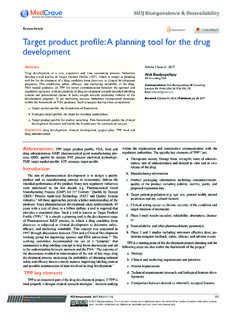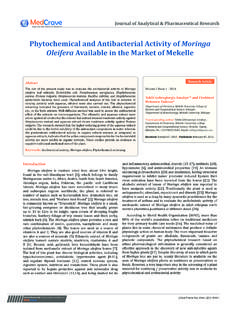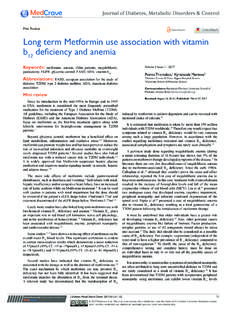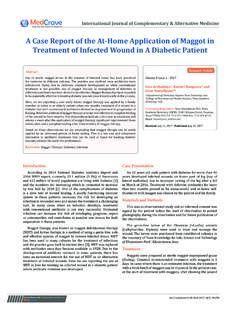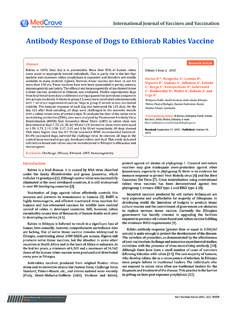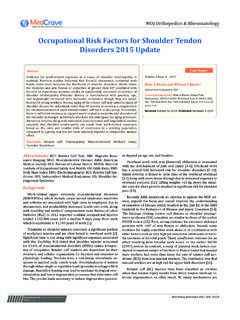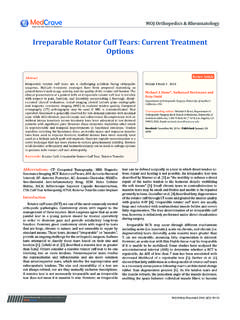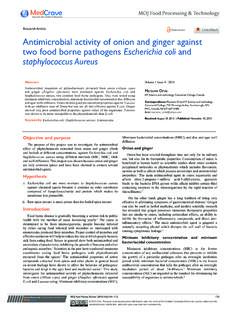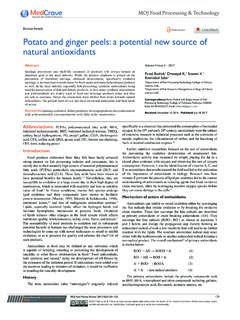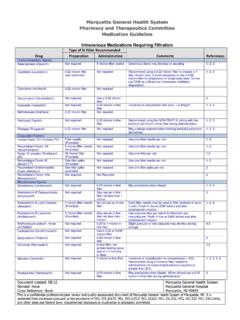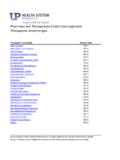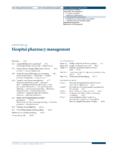Transcription of Description of an anesthesia/perioperative medicine ...
1 Submit Manuscript | : SCIP, surgical care improvement project; PACU, post- anesthesia care unit; NPSGs, national patient safety goals; OR, operating room; TJC, the joint commissionIntroductionThe role of the pharmacist in the perioperative setting and operating room (OR) has long been well The implementation of an OR pharmacy and provision of clinical pharmacy services has been shown to reduce inventory costs, reduce lost revenue, improve medication distribution, improve patient charging, improve intravenous compounding and labeling, and improve narcotic control and ,2 Further, pharmacists trained in the perioperative setting can reduce the incidence of adverse drug events, improve compliance with surgical care improvement project (SCIP)
2 Measures, mitigate drug diversion and serve as a drug information specialist to surgeons, nurses and health care professionals working in the surgical or post- anesthesia care unit (PACU) setting. A pharmacist trained to provide pharmaceutical services in the perioperative setting is also better prepared to provide surveillance of adverse drug events in this setting and participate on multi-disciplinary committee s to improve health care the last 25years the number of OR pharmacies in hospitals has more than doubled, yet few learning experiences for pharmacy students and pharmacy residents exist to meet this growing Most pharmacists who work in the perioperative setting or in an OR pharmacy have learned to do so from on the job training.
3 Since much of the knowledge needed to function effectively in the perioperative setting is not taught in the doctor of pharmacy curriculum. To our knowledge the only literature describing a pharmacy student experience in the OR setting comes from The American Society of Health-System Pharmacists (ASHP), and one paper outlining the establishment of a clinical pharmacy OR rotation for pharmacy ,5 We identified no literature describing a pharmacy resident learning experience in the OR. The purpose of this descriptive report is to outline the structure of our post-graduate year one (PGY-1)
4 rotation in anesthesia / perioperative medicine and to outline how we meet the PGY-1 ASHP residency accreditation standards through this learning settingThe PGY-1pharmacy residency program at our institution is 12months in duration and consists of training in many aspects of pharmacy practice including core rotations in internal medicine , critical care, emergency medicine , surgery, anesthesia / perioperative medicine , infectious diseases and two electives. Longitudinal experiences include anticoagulation, nutrition support, research, administration and a pharmacy practice service commitment.
5 Our anesthesia / perioperative medicine rotation is a 4week required rotation that is spent primarily in the OR pharmacy . Our institution is a 369-bed community hospital within a large health-system and has 15 operating rooms, 2 labor and delivery rooms, 2 cystoscopy suites, an ambulatory surgical care unit consisting of 16 beds and a 15 bed PACU. We also have 4 exam rooms for outpatient/pre-operative assessments as a part of our outpatient services. The OR pharmacy provides pharmaceutical care services 16hours per day Monday through Friday and is staffed by one clinical pharmacy specialist and two pharmacy technicians.
6 We describe in Table 1 the activities that are required during the 4week rotation Pharmacol Int J. 2016;4(3):361 2016 Cowart et al. This is an open access article distributed under the terms of the Creative Commons Attribution License, which permits unrestricted use, distribution, and build upon your work of an anesthesia / perioperative medicine rotation for post graduate year one pharmacy residentsVolume 4 Issue 3 - 2016 Kevin Cowart,1 Aranjeet Sidhu,2 Michael Willis31 PGY-1 pharmacy Resident, Duke Regional Hospital, USA2 Clinical Pharmacist, perioperative Services, Duke Regional Hospital, USA3 Clinical Coordinator & PGY-1 Residency Program Director, Duke Regional Hospital, USAC orrespondence.
7 Kevin Cowart, PGY-1 pharmacy Resident, Duke Regional Hospital, 3643 North Roxboro Road Durham, USA, Tel 9194704188, Fax 9194707384, Email Received: May 05, 2016 | Published: May 24, 2016 AbstractPurpose: The purpose of this descriptive report is to outline the structure of our post-graduate year one (PGY-1) rotation in anesthesia / perioperative medicine and to outline how we meet the PGY-1 ASHP residency accreditation standards through this learning : Sparse evidence exists to describe pharmacist training opportunities in anesthesia / perioperative medicine . A PGY-1 rotation in anesthesia / perioperative medicine can prepare a pharmacist to practice in this setting and meet the PGY-1 ASHP residency accreditation standards through several learning experiences including pharmacy practice/service, compliance, education/scholarship, clinical experiences and transitions of : The PGY-1 rotation in anesthesia / perioperative medicine prepares a pharmacist to practice and assume leadership for perioperative medication management in the perioperative setting.
8 PGY-1 pharmacy residency programs should consider a rotation in this setting as an opportunity to meet the growing need for pharmacists who can advance pharmacy practice and take on leadership roles in the perioperative : pharmacy , ASHP accreditation standards, pgy-1 pharmacy residencyPharmacy & Pharmacology International Journal Research ArticleOpen AccessDescription of an anesthesia / perioperative medicine rotation for post graduate year one pharmacy residents362 Copyright: 2016 Cowart et : Cowart K, Sidhu A, Willis M. Description of an anesthesia / perioperative medicine rotation for post graduate year one pharmacy residents.
9 Pharm Pharmacol Int J. 2016;4(3):361 365. DOI: of the rotation experienceThe goal of the rotation is to allow the PGY-1 pharmacy resident to become an independent pharmacy practitioner in the OR environment and an integral member of the surgery team. At the conclusion of the rotation , the resident will have the skills and practice attitudes necessary to establish and advance pharmacy practice in the OR environment. During the rotation , the resident is responsible for ensuring safe and effective therapeutic management of all surgical and post-operative pain and emesis medications.
10 The resident is also responsible for completing daily audits of controlled substance inventory management and handling administrative responsibilities associated with the OR pharmacy , such as authorizing access to medication distribution systems for OR personnel. Other pharmaceutical services provided by the resident may include quality improvement projects and formulary strategy & learning objectivesOur PGY-1 pharmacy residency program utilizes Pharm Academic to evaluate and document achievement of the PGY-1 pharmacy residency objectives. A formative self-evaluation is completed by the resident prior to the start of the rotation , a midpoint evaluation is completed by the preceptor at the end of week 2, and a summative evaluation is completed by the resident and preceptor at the conclusion of the 4week rotation .
